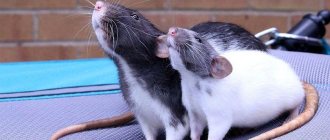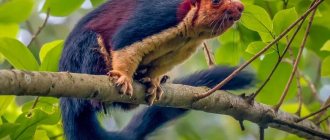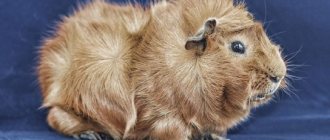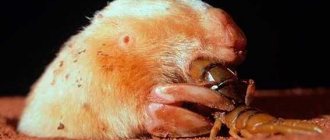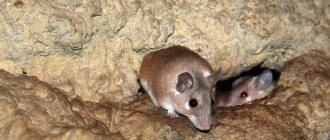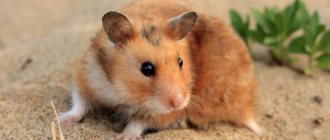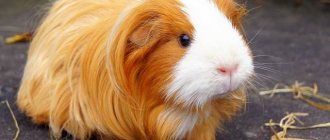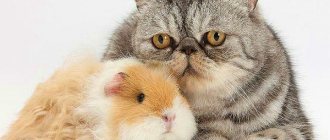The most numerous order of mammals are rodents. A total of 2,277 species have been described. They can be found almost everywhere, anywhere on our planet, with the exception of Antarctica and some islands.
Typically, all rodents are small in size, from 5 to 130 cm, but on average do not exceed 50 cm. Many of them have a particularly long tail, which is significantly larger than their body size, but some have it completely absent, such as sea pigs.
The smallest rodent is only 3 cm in length (plus 2 cm for the tail), it weighs only 7 g. Some rodents are impressive in their size. Thus, the average weight of a capybara is 65 kg, and individual specimens weigh up to 91 kg.
The largest are rodents, which have long since become extinct. The remains of giant representatives of this group were found, the largest of which weighed from 1 to 1.5 tons, it is possible that it reached a size of 2.5 tons. Nowadays it is impossible to meet such giants.
But still, the largest rodents in the world amaze with their size, despite the fact that in our society there has long been a stereotype that if it is a rodent, then it is a tiny animal that fits in the palm of your hand.
Capybara
The capybara is the world's largest rodent, which lives near rivers and lakes in South and Central America. This herbivorous semi-aquatic animal is recognized as the only representative of the capybara suborder. The weight of an adult reaches 65 kilograms, and the body length is 110-130 cm. Females are much larger than males and weigh up to 125 kg during the period of bearing offspring.
Despite such impressive size, capybaras are kind and friendly. They feed on plant foods, including algae and root vegetables. Animals are not afraid of people and gladly take food from their hands, but they prefer to stay away from settlements.
Mice of Gough Island
Situated in the South Atlantic, Gough Island has been overrun by approximately two million mice. Uninhabited areas have become an ideal breeding ground for them. It is noteworthy that rodents are twice as large as their counterparts living in the civilized world. Every year, 1.6 million petrel chicks are born on the island, and 1.2 million of them are eaten by mice.
Shearwaters are also eaten by black rats that have settled on the Tristan da Cunha archipelago, where, as on Gough Island, these rodents have no natural predators. Experts, in turn, continue to search for the best method for exterminating these pests, because even one surviving pregnant female can give birth to new rats that will multiply quickly. But scientists do not lose hope. In 2009, complete eradication of rats was achieved on Rat Island (Alaska), where rodents lived for 230 years.
Beaver
There are two varieties of beavers - Canadian and Mongolian. The second type of rodent is considered the largest. The length of a mature male reaches 1.5 meters, and body weight ranges from 30-35 kilograms. Beavers are extremely hardworking creatures, they are constantly engaged in building houses and dams, and spend a lot of time searching for food and training their offspring. The peculiarity of animals is their strong teeth and powerful jaws. They easily chew through the hard bark of trees and are capable of felling an oak or tall spruce in a short time.
Beavers' eyelids are transparent, which allows them to see clearly under water. The tail of animals is multifunctional. It regulates body temperature, helps change direction while swimming and express emotions.
Characteristics and description
In nature, capybaras form small groups of up to 20 individuals, consisting of one male, several mature females and their cubs. The dominant position in the community is occupied by the male, followed by females, who also have a division by status. Animals have a calm character and rarely engage in fights with representatives of their own species. The exception is the need to confirm status in the group.
During periods of drought, when rodents gather near the deepest areas of a reservoir, the number of individuals in a family can increase to several dozen.
The capybara is diurnal. During daylight hours, groups of giant rodents graze on the banks of reservoirs or swim, cooling off in the water during the hottest hours. In search of food, capybaras are able to dive, remaining under water for 3-5 minutes.
In the process of evolution, the animal acquired certain features of adaptation to its environment. These, for example, include membranes between the toes, which allow them to swim well and dive to depth, as well as hard, sparse, abundantly covered with fat wool, which repels water well.
Since the main food competitors of capybaras are ungulates, during the struggle for food areas the rodent acquired a certain similarity with them both in appearance and in habits. Thus, the structure and location of the limbs makes it possible to run quickly and jump. Unlike other rodents, capybaras do not dig holes or build other shelters, so at night they sleep right on the ground, like ungulates. Water pig cubs are not born blind and helpless, like other rodents, and immediately after birth they can follow the family.
Animals are able to communicate and transmit information to each other using a variety of sounds: whistles, barks, squeals, grunts and clicks.
What does it look like
The appearance of the capybara has the following features:
| Body | Large, massive, barrel-shaped, with a small, almost invisible tail. |
| Head | Large, short-necked, rectangular in shape, with a blunt snout. The eyes and small rounded ears are located on top, which allows the animal to be almost completely submerged under water. |
| Limbs | Thin, much longer than other representatives of the order. There are 4 toes on the front paws and 3 on the hind paws. |
| Teeth | The capybara has 10 teeth on each jaw. The enamel on the outside of the incisors is white, not yellowish like that of most rodents. The main load when chewing food falls on the cheek teeth, which continue to grow throughout life. |
| Color | Solid color, varies from dark brown to light brown. |
Dimensions
The average height of sexually mature individuals reaches 50 cm, and the body length is 1.3 m. Males are usually slightly smaller than females. The maximum weight of a capybara is 65 kg, but not all individuals grow to such a size. Animals living in nature weigh on average 40-50 kg. Capybara cubs that are just born have a mass of 1-1.5 kg.
Mara
The animal lives on the rocky plateaus of Argentina and Patagonia and looks slightly like a kangaroo. Mara is a distant relative of the well-known domestic guinea pig and belongs to the half-ungulate family. An adult rodent weighs about 20 kilograms, and its body length often reaches 50 centimeters.
In Patagonia, locals call the maru the lowland hare, since the rodent's hind legs are much longer than its front ones and help it jump long distances. In addition, the habits of the mara are similar to those of a hare. When an animal runs away from a predator, it jumps in a zigzag pattern, straining all 4 legs at the same time.
What does it eat?
Capybaras are herbivores. The basis of their diet is grass, aquatic plants, juicy tubers, fruits of trees and shrubs. During dry seasons, rodents are forced to gnaw bark from branches and trunks and eat hard reeds surrounding rivers and lakes.
During periods when animals eat tougher and drier food, they often regurgitate the partially digested green mass and chew it again.
Like many herbivores, the capybara eats its own excrement. In this way, the rodent replenishes the intestinal bacterial flora to improve the digestion of tougher food.
Massoutiera
The largest representative of the comb-toed family and the only rodent on Earth from the genus Massoutiera. The animal's habitat is Mali, Nigeria, the Republic of Chad, Algeria. Masseurs live mainly in mountainous areas and lead a diurnal lifestyle. The male's body length is 24 centimeters, and his weight is 160-170 grams. Females are 14-18% larger.
Since 2015, masseurs have been listed in the Red Book as an endangered species. Rapid declines in rodent populations have been observed in areas where livestock farming flourishes and drought seasons regularly occur. To protect the species from extinction, reserves are being opened in Africa where the massier is kept.
Reproduction
Capybaras reach sexual maturity at 1.5 years. Sexual activity usually coincides with the beginning of the rainy season, so the timing of mating season can vary greatly in different parts of the mainland. Mating of rodents occurs in water, with the dominant male usually covering all females of the family.
Pregnancy lasts 5 months. Females do not prepare nests or secluded places and bring offspring right where the family rests. There are from 2 to 8 babies in one litter. A baby capybara can stand on its feet almost immediately after birth. A newborn animal is an exact copy of its parents: its eyes are open, its body is covered with fur, and it has teeth in its mouth. The only difference is the lighter color of the fur. Babies begin to feed on their own and eat solid food at 4-5 days, although females continue to feed them with milk for several months.
Capybaras living in the same family take care of the growing offspring together, and females can feed both their own and other people’s cubs.
MONKEY
Pacarana
Pacarana is the only representative of the Pacarana family. Rodents inhabit countries such as Colombia, Bolivia, Peru, and Venezuela. Less common in Brazil and Ecuador. Pacaranas prefer to settle deep in tropical rainforests, away from humans. The body length of an adult animal is at least 73 centimeters, and its weight ranges from 11 to 15 kilograms.
In preparation for childbirth, females make cozy nests in deep crevices of the earth or rocks so that their offspring do not fall into the clutches of predators. A newborn pacarana weighs 850-900 grams. Animals feed on vegetation, mainly grass and berries.
Viking rats
In 2014, an unusually large rat, more than 15 inches, appeared in the kitchen of the Bengtsson-Korsas family (Solna, Sweden). The rodent made passages in wood and concrete to get into the room. To destroy the pest, homeowners used the largest trap. The rat was so large that only its head could fit into the rat trap. She did not die immediately, but suffocated in her tunnel. The family first realized something was wrong when their cat, Enoch, became afraid to go into the kitchen.
Based on a number of studies and observations conducted in Europe, the UK and the USA, the appearance of so-called Viking rats may indicate abnormal development of individuals and various types of mutations. Experts who have monitored the rodents say they are twice the size of regular rats. In Dublin, exterminators caught a 24-inch rat in an apartment.
In addition, Viking rats are immune to poisons. Bromadiolone no longer works on them. According to a 2009 University of Huddersfield study, genetic mutation and immunity to poisons go hand in hand in this case, forcing specialists to create new, more effective poisonous drugs.
Crested porcupine
Another name for the animal is the crested porcupine or typical porcupine. The largest and most famous representative of the Hystricidae family. The creatures live in Europe, India, North Africa, China, Transcaucasia and Iraq. The body length of an adult is over 85 centimeters, and its weight is 25-27 kilograms.
A special feature of porcupines is the long quills that line their backs and serve as a means of defense against natural enemies. In dangerous situations, the animal throws out needles. They dig into the attacker's body and cause severe pain. The most common victims of tufted porcupines are curious dogs, farm animals and children.
Enemies
In nature, capybaras often become victims of large mammalian predators: wild dogs, jaguars, ocelots. Small cubs are attacked by vultures and harpies. When danger approaches, capybaras give a signal to their family. Rodents escape from land-based predators in water. They submerge almost completely in the water and sit tightly pressed against each other, while adult animals surround the cubs and juveniles inside.
In water, an anaconda, alligator, caiman, and crocodile can attack a pig.
CROCODILE
Baybak
The baybak or common steppe marmot inhabits almost the entire territory of the Eurasian virgin steppes. He is the largest representative of the squirrel family. The body length of the male reaches 80 centimeters, and the weight is from 10 to 13 kilograms. A distinctive feature of the boibak from other types of marmots is its shortened tail. Its length does not exceed 15 centimeters.
Among these animals, albinos are often found, which are caught and kept as rare pets. Boibaks feed on hay, grain crops, grass and root crops. During periods of famine, they climb into vegetable warehouses and destroy food supplies.
Application on the farm
Capybaras are bred on farms, which are especially numerous in Venezuela. This business is very profitable, since the animals are easy to care for, do not get sick, and a pond and green grass are important for their comfort.
Capybara skin is used in light industry for the manufacture of clothing, shoes, and other products. Their meat tastes and looks very similar to pork and is widely used in cooking. Rodent fat is valuable in pharmaceuticals.
The number of capybaras on the farm can reach 30 thousand. This overcrowding has caused an outbreak of spotted fever in Venezuela, since it is transmitted by the ixodid tick, which parasitizes these “mistresses of grass.”
Flanders
The animal was nicknamed the Belgian giant because of its incredible size among the representatives of the rabbit family. An adult rodent grows up to 70 centimeters in length, and particularly well-fed individuals can weigh 24-25 kilograms.
Flanders are bred to obtain skins with thick, beautiful fur, from which sheepskin coats, mittens, hats, and nutritious meat are sewn. Less commonly, this breed is kept as a decorative pet. Belgian giants are famous for their fertility. A person who decides to engage in rabbit breeding by purchasing a pair of flanders will become the owner of a large rabbit farm in 2 years.
Long observations of the behavior of Flanders allowed scientists to conclude that they are very smart and friendly. Rodents easily make contact with people and get along with other pets in the house.
Cute pet
Before purchasing a capybara to live at home, you need to weigh your options and decide whether you can provide your pet with what it needs.
Namely:
- temperature conditions;
- a reservoir of considerable size;
- regular walks in nature.
Buying an animal
The sale of rodents is not prohibited.
Animals are most often brought to order from South America, but you can try to buy a capybara here:
Buying a young animal will cost 100-260 thousand rubles. First of all, this is the cost of transportation and the procedure for processing all necessary documents.
Care
Keeping a capybara at home is not easy. The animal quickly gets used to the person and asks for his attention and care.
The owner should remember some features of caring for a water pig:
- The capybara, like any other pet, needs health monitoring, and therefore needs annual vaccinations. If you do not plan to breed rodents, then it is better to castrate the male at a young age, so that later, when he reaches puberty, he does not perceive the owner as an object of courtship.
- The tropical animal feels good in its native climate, that is, in warmth with high humidity. Living in the middle zone or in the north, it is necessary to create such conditions artificially.
- The capybara spends most of its time in water, where it needs to actively move, which means the reservoir must be of considerable size.
- The animal's walking area must be carefully fenced so that the freedom-loving pig does not leave the designated area, and is also protected from dogs. In the city, a calm animal walks well on a leash.
- Capybaras are unpretentious in food; their diet consists only of plant foods. They eat everything that grows, you can also use granulated food for rodents or dogs (the largest granule size), vitamin supplements are required. The animal must be given the opportunity to sharpen its teeth; tree branches and sticks are suitable for this.
- A sociable capybara asks for the attention of its owner. If there are other animals in the house, she will easily make friends with them, but in the absence of them she will be bored. It can show aggression (even towards a person) in case of self-defense. You will have to get used to the capybara's voice: it almost constantly makes many sounds, thus communicating with its fellow tribesmen or its owner. The range is quite wide: squealing, whistling, clicking, grinding, barking. They remain this way throughout their life in captivity (10-12 years).
- No care is required for the appearance of the animal. The capybara puts its body and fur in order on its own.
The most famous tame capybara
Capybara named JoJo has become the most famous rodent on the planet thanks to his good nature, photogenicity and global social network. Her page (its owner) had more than 120 thousand subscribers, and films with the YouTube star pig were watched by about 10 million viewers.
The capybara lived in America. Her owner, Kennedy, purchased the little piglet from a breeder for $800. It took me a long time to come up with a nickname; the animal ignored any appeal to itself. Finally, it responded to “Jojo.”
The last photos show that the not very thick hair of the water pig began to thin out more and more, and bald spots appeared. The owner commented on this fact: “He’s getting old.” But obviously JoJo was getting sick. In August 2022, he died, having lived only 5 years, which is short even for natural conditions.
Indian giant squirrel
The Indian ratufa is recognized as the most beautiful representative of the squirrel family. This is a huge herbivorous squirrel that lives in trees and is diurnal. Animals of this species live in the forests of Hindustan, most of them near the state of Madhya Pradesh.
The color range of the Indian ratufa consists of three shades, the body length is up to 65 centimeters, and the weight of an adult individual does not exceed 2300 grams. Rodents feed on tree fruits, leaves, small insects and root vegetables.
Nutrition
Rodents eat a variety of foods, including leaves, fruits, seeds and small invertebrates. Cellulose foods are digested in the cecum (a sac in the digestive tract that contains bacteria that can break down solid plant material into a digestible form). Food is either eaten where it is collected, or it is brought into burrows for storage (for example, gopher rats, Gambian rats, hamsters, etc.). Species living in arid habitats and on oceanic islands can obtain essential fluids from their food.
Soviet chinchilla
The largest breed of domestic rabbits, bred for their fur on private farms in Russia and the CIS countries. It was obtained by crossing American small chinchillas with white giant rabbits. The bred animal is large in size: body length - 70-75 centimeters, weight - 5-6 kilograms, subject to proper feeding and maintenance. A feature of Soviet chinchillas was their high fertility. A female gives birth to up to 15 cubs per year, which gain a weight of 2 kilograms in 60 days.
Nutria
Its other names are swamp beaver or koipu . " Nutria " is translated from Greek as "mouse-beaver". In appearance it resembles a rat of enormous size: the body grows up to 60 cm, the tail is 45 cm, it weighs from 5 to 12 kg. Males are usually larger than females.
She has a huge head with small ears and eyes, and a blunt muzzle. The tail is hairless, it is a kind of rudder that is used when swimming. The fur of this animal is waterproof and brown.
Nutria lives in South America, but it has been able to acclimatize in many countries. It is active at night. Lives in groups of 2-13 individuals.
Speckled gopher
The speckled gopher or prairie dog is the most common rodent in Eastern Europe, the banks of the Danube and Volga. They also inhabit countries such as Belarus and Ukraine. Speckled gophers live in dry meadows, forest belts, plantings and near water bodies. The body length of a mature prairie dog reaches 25 centimeters, and its weight does not exceed 700 grams. The gopher, having left its parent's nest, begins to equip its house. In it he raises offspring, spends the summer and hibernates.
Where does it live?
Capybaras are endemic to South America. The habitat extends to most of the continent except the highlands of the Andes and southern regions with a temperate climate.
Where does he live?
The capybara's habitat is areas near rivers, lakes or swamps. The natural areas where the rodent lives include wet and dry tropical forests and woody savannas. They can be found in foothill areas at an altitude of up to 1300 m above sea level.
Since rodents spend most of the day in the water, their traditional habitat is coastal areas. Typically, capybara families do not move more than 500-1000 m from their body of water.
Belgian giant
And now to domestic rodents. Two rabbits of this breed live in the UK, and their owners staged a competition to see which one could grow the biggest. It is a mistake to classify rabbits as rodents, because they belong to the order Lagomorpha. But people often refer to them as rodents. It is not for nothing that Carl Linnaeus initially identified rabbits and rodents as a single class of rodents.
Ralph the rabbit, with a weight of 22 kilograms, is the heaviest on the planet, but Darius made it into the book of records because of his body length, which is 1.3 meters.
Perhaps Darius will be overtaken by his own son, nicknamed Jeff. Which has already reached a length of 1 meter, and by the age of maturity the length of the rabbit can increase significantly.
And there is a very interesting article on thebiggest about the largest breeds of rabbits.
4
